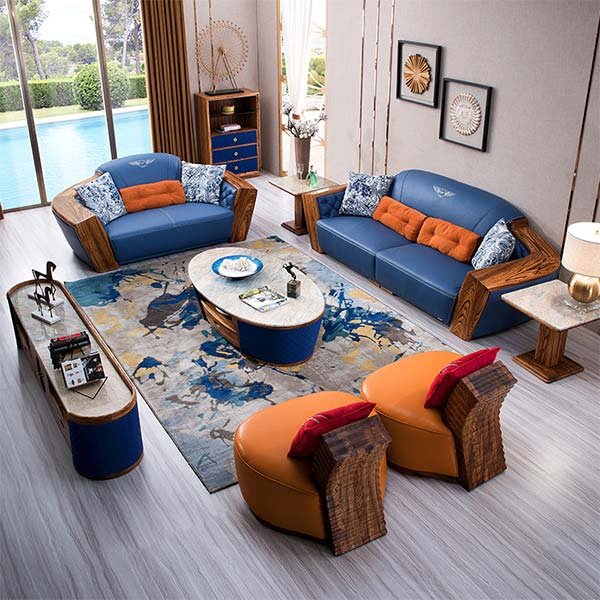“Embrace nature’s beauty, choose wooden furniture for eco-friendly interiors.”
Sustainable Sourcing of Wood for Furniture
Sustainable Sourcing of Wood for Furniture
Wooden furniture has always been a popular choice for interior design due to its timeless beauty and durability. However, in recent years, there has been a growing concern about the environmental impact of furniture production. As a result, the role of wooden furniture in creating eco-friendly interiors has become increasingly important. One key aspect of this is the sustainable sourcing of wood for furniture.
Sustainable sourcing refers to the practice of obtaining wood from responsibly managed forests. This means that the wood is harvested in a way that ensures the long-term health and productivity of the forest ecosystem. Sustainable sourcing also takes into account the social and economic well-being of the local communities that depend on the forest for their livelihoods.
One of the main challenges in sustainable sourcing is the illegal logging of trees. Illegal logging not only contributes to deforestation but also undermines the efforts of responsible forest management. To address this issue, many countries have implemented strict regulations and certification systems to ensure that wood used in furniture production comes from legal and sustainable sources.
One such certification system is the Forest Stewardship Council (FSC). The FSC sets standards for responsible forest management and provides a certification process for wood products. By choosing furniture made from FSC-certified wood, consumers can be confident that they are supporting sustainable sourcing practices.
In addition to certification systems, sustainable sourcing also involves promoting the use of locally sourced wood. This reduces the carbon footprint associated with transportation and supports local economies. By using locally sourced wood, furniture manufacturers can also ensure that the wood comes from sustainably managed forests within their own region.
Another important aspect of sustainable sourcing is the use of reclaimed wood. Reclaimed wood refers to wood that has been salvaged from old buildings, barns, or other structures. By repurposing this wood, furniture manufacturers can reduce the demand for new wood and minimize waste. Reclaimed wood also adds a unique character and history to furniture, making it a popular choice for eco-conscious consumers.
Furthermore, sustainable sourcing extends beyond just the wood itself. It also involves considering the entire lifecycle of the furniture, from production to disposal. This includes using non-toxic finishes and adhesives, as well as designing furniture that can be easily disassembled and recycled at the end of its life.
In conclusion, the sustainable sourcing of wood for furniture plays a crucial role in creating eco-friendly interiors. By choosing furniture made from responsibly managed forests, consumers can support the preservation of natural resources and the well-being of local communities. Certification systems like the FSC, as well as the use of locally sourced and reclaimed wood, are important steps towards achieving sustainable sourcing practices. Additionally, considering the entire lifecycle of furniture ensures that it is not only environmentally friendly but also durable and long-lasting.
Benefits of Using Wooden Furniture in Eco-Friendly Interiors
Benefits of Using Wooden Furniture in Eco-Friendly Interiors
Wooden furniture has long been a popular choice for interior design, and for good reason. Not only does it add a touch of warmth and natural beauty to any space, but it also has numerous benefits when it comes to creating eco-friendly interiors. In this article, we will explore the various advantages of using wooden furniture in sustainable design.
One of the primary benefits of wooden furniture is its sustainability. Unlike furniture made from synthetic materials or metals, wood is a renewable resource. Trees can be replanted and harvested, making it a more environmentally friendly choice. Additionally, many manufacturers now use sustainable forestry practices, ensuring that the wood they use comes from responsibly managed forests.
Another advantage of wooden furniture is its durability. When properly cared for, wooden pieces can last for generations. This means that they do not need to be replaced as frequently as furniture made from other materials, reducing waste and the need for production. Additionally, wooden furniture can often be repaired and refinished, further extending its lifespan.
Wooden furniture also has the ability to improve indoor air quality. Unlike synthetic materials, wood does not release harmful chemicals or off-gas volatile organic compounds (VOCs). This is particularly important for individuals with allergies or respiratory conditions, as well as for creating a healthy living environment for everyone.
In addition to its environmental and health benefits, wooden furniture also offers aesthetic advantages. The natural grain and texture of wood can add a sense of warmth and character to any space. Whether it is a rustic farmhouse or a modern minimalist design, wooden furniture can complement a variety of interior styles.
Furthermore, wooden furniture is versatile and can be easily incorporated into different design schemes. It can be stained or painted to match any color palette, allowing for endless possibilities in terms of customization. This makes it a great choice for those who want to create a unique and personalized interior.
When it comes to maintenance, wooden furniture is relatively easy to care for. Regular dusting and occasional polishing are usually all that is needed to keep it looking its best. Additionally, any scratches or dents can often be repaired with simple DIY techniques, saving both time and money.
Lastly, wooden furniture holds its value well. Unlike mass-produced, disposable furniture, high-quality wooden pieces can retain their value over time. This makes them a wise investment for those who are looking to furnish their homes with long-lasting and sustainable items.
In conclusion, the benefits of using wooden furniture in eco-friendly interiors are numerous. From its sustainability and durability to its positive impact on indoor air quality, wooden furniture is a smart choice for those who want to create a healthy and environmentally conscious living space. Additionally, its aesthetic versatility and ease of maintenance make it a practical and stylish option. By choosing wooden furniture, you can not only enhance the beauty of your home but also contribute to a more sustainable future.
Tips for Maintaining and Caring for Wooden Furniture in an Eco-Friendly Way
Wooden furniture is not only aesthetically pleasing but also a sustainable choice for creating eco-friendly interiors. However, to ensure its longevity and minimize its environmental impact, proper maintenance and care are essential. In this article, we will provide you with some valuable tips on how to maintain and care for wooden furniture in an eco-friendly way.
First and foremost, it is important to keep your wooden furniture clean. Regular dusting with a soft cloth or a feather duster will help remove any dirt or debris that may accumulate on the surface. Avoid using harsh chemical cleaners as they can strip the wood of its natural oils and finish. Instead, opt for natural cleaning solutions such as a mixture of vinegar and water or a mild soap diluted in water.
In addition to regular cleaning, it is crucial to protect your wooden furniture from excessive moisture. Wood is a natural material that can absorb moisture, which can lead to warping or cracking. To prevent this, avoid placing your furniture in areas with high humidity or direct sunlight. If you live in a particularly humid climate, consider using a dehumidifier to maintain optimal moisture levels in your home.
Another important aspect of caring for wooden furniture is to avoid placing hot or wet objects directly on its surface. Heat can cause the wood to expand and contract, leading to cracks or damage. Always use coasters or trivets to protect the surface from hot dishes or beverages. Similarly, wipe up any spills immediately to prevent water damage.
To maintain the natural beauty of your wooden furniture, it is recommended to apply a protective finish or sealant. This will not only enhance its appearance but also provide a barrier against stains and scratches. Be sure to choose a finish that is eco-friendly and non-toxic. Natural oils such as linseed oil or beeswax are excellent options as they nourish the wood and create a beautiful sheen.
When it comes to moving or rearranging your wooden furniture, it is important to handle it with care. Lift the furniture instead of dragging it to avoid scratching or damaging the floor. If you need to disassemble or reassemble any parts, follow the manufacturer’s instructions carefully to avoid any mishaps.
Lastly, regular maintenance is key to preserving the lifespan of your wooden furniture. Inspect it periodically for any signs of wear or damage. If you notice any scratches or dents, consider using a touch-up pen or furniture marker to conceal them. Additionally, it is recommended to polish your wooden furniture every few months to restore its shine and protect it from everyday wear and tear.
In conclusion, maintaining and caring for wooden furniture in an eco-friendly way is essential to ensure its longevity and minimize its environmental impact. By following these tips, you can enjoy the beauty of wooden furniture while contributing to a sustainable lifestyle. Remember to clean it regularly, protect it from moisture and heat, apply a protective finish, handle it with care, and perform regular maintenance. With proper care, your wooden furniture will continue to enhance your eco-friendly interiors for years to come.
Заключение
Заключение: Деревянная мебель играет важную роль в создании экологически чистых интерьеров. Она является натуральным и возобновляемым материалом, который не загрязняет окружающую среду при производстве и утилизации. Деревянная мебель также способствует созданию уютной и природной атмосферы в помещении. Она может быть изготовлена из экологически чистых пород дерева и обработана натуральными отделочными материалами, что делает ее безопасной для здоровья и экологически дружественной. В целом, использование деревянной мебели в интерьере способствует созданию экологически устойчивых и приятных для проживания или работы помещений.



